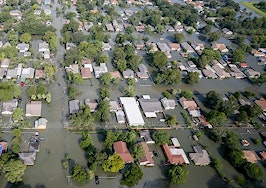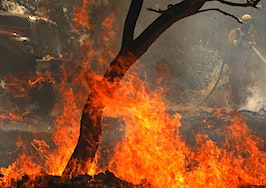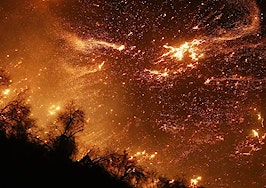Scorching wildfires. Ferocious floods. Destructive hurricanes. Smothering mudslides. These are the real-life disasters Americans in California, Florida, Texas and Puerto Rico have been struggling to recover from over the past year alone.
As they start to rebuild, one thing has become clear, most homeowners didn’t have the proper insurance.
In California, homeowners struggled to afford premiums in high-risk zones. In Houston, congressional struggles with reauthorizing the National Flood Insurance Program hovered over the recovery process like a dark cloud. And in Puerto Rico, recovery efforts have been tied up due to a weak infrastructure and political battles.
So how can you make sure you’re prepared for the next natural disaster?

Tom Larsen
CoreLogic Senior Content Strategy Director Tom Larsen sat down with Inman to explain the ins and outs of home insurance and what we all need to be aware of.
Q: Let’s start with the basics. What does every buyer or homeowner need to know about their home insurance in terms of natural disaster coverage?
A: If you’re talking about a homeowner who has purchased a basic policy, your losses from [a] wildfire are covered.
However, the burden is on the homeowner to make sure you buy a sufficient amount of insurance. Just adding a policy doesn’t guarantee that if your house burns down the insurer will provide you with enough money to replace everything. The premium is based on how much it might cost to rebuild.
That’s a lesson that many are learning after these fires [in California]. You need to make sure you have enough to pay for that. Look at your policy form and do the best you can to determine if you have a reasonable amount of insurance.
People think of the value of their home in terms of what’s it worth and the purchase price, but your insurance company looks at the reconstruction cost where, in some areas, it may outweigh what you initially paid for it. For example, in California, there is a post-catastrophe inflation of labor costs because now everybody in the area wants to rebuild, not just you.
To make sure this doesn’t happen, check your coverage, check the declarations, and if necessary, reach out to an appraiser or find out what other people in your neighborhood have.
Q: What about floods and hurricanes? How can homeowners make sure they have enough insurance for those events?
A: Flood insurance is a different conversation. Fire insurance is required as a condition of your mortgage. Your mortgage service provider usually has to ensure it’s been purchased before closing. For a flood, coverage is not automatic. The acronym we use when talking about floods is SFHA, a special flood hazard area. Inside [SFHAs], we have a mandatory purchase that’s enforced by mortgage lenders, so that if you are, in fact, inside one of these zones you do have insurance.
Outside of those zones, it is optional. For most people, optional means, “Oh, I don’t have to do it, so I won’t buy it.” But, then you get a Hurricane Harvey.
At CoreLogic, we have analytical and data models telling us where all the homes are located. After Hurricane Harvey, we published a statistic that showed 70 percent of the flood damage was uninsured to the tune of $20 [billion] to $30 billion.
It’s a reminder that the flood risk isn’t binary. It’s not, “Oh I’m not in a flood zone so my house can’t get flooded.” Most of the homes in this country have some kind of probability, a low probability, of getting flooded. It may only be in the worst events, but you never know.
The National Flood Insurance Program (NFIP) was set up a long time ago to be able to protect the most frequently flooded homes. However, you don’t want to be lulled into thinking you won’t have damage because you’re not in a flood zone.
Q: It seems that the majority of homeowners are completely unaware of their natural disaster risk. Is there any way homeowners and buyers alike can check for the level of risk to a property?
Full disclosure — we sell this kind of information on a property by property basis to insurers and mortgage issuers. I’m not aware of any good, free site that I would advise somebody to go to. I work in this field, so I could find it. But, there aren’t any really good single-source [sites] where you could type in your address and really get an understanding of your risk, and I think that’s what you want to talk with people about.
But, let’s say you did a check a year ago, I think a lot of those risk determinations are changing right now. The most notable [thing] about the Santa Rosa fires was that it burned Coffee Park, a residential neighborhood miles away from the wildfire and wildland zones that are normally associated with these events.
That area was filled with sidewalks, streets, and homes, not a large, forested area where intuitively you’d know you are at risk.
It was a really tough lesson those people had to learn and we have to understand that we all have some kind of [natural disaster] risk.
Q: In light of what happened at Coffee Park, how often do homeowners need to revisit their policy to make sure their coverage matches their current risk?
The standard practice would be to review it every year with your renewal. That perhaps is even too frequent. You might just check when you are going through a life event. A career change and acquiring more valuable assets, having children or changing your house are triggers for doing a more serious review.
When it comes to covering your assets, you need to look on the declaration page of your policy. There’s a stated limit for your contents, but it doesn’t mean if the home is burned down you’ll automatically get that check. Most insurers will require you to provide a list of what you owned and then they’ll reimburse you.
The California Department of Insurance (CDI) has tried to make it more automatic and to provide a more liberal payout but insurers are fighting back. This is why it’s important for you to keep an inventory of everything you own. It seems obvious, but most people, especially those who have been living in the same place for a long time, don’t have a perfect recollection of what’s inside their home.
Q: We’ve talked about what homeowners need to do before a natural disaster, but what are the initial steps homeowners need to take after something happens?
The normal process is pretty clear. Protecting lives and personal safety is first. You need to secure a safe place to stay, and homeowners need to recognize they’ll be doing this simultaneously with tens of thousands of their neighbors.
Call your homeowners’ insurance right away. They will pay for your additional living expenses, such as the cost of staying in a hotel. You have to remain up to date on your mortgage — a fire (or another event) does not give you automatic dispensation to pay your mortgage.
You’re going to have to alert your mortgage provider as well because when you start the reconstruction process, they have a lien on your property so the insurance payments are going to have to be coordinated with them.
The sooner you begin that notification process and learn how to get that working, you’ll get access to the money you need.




